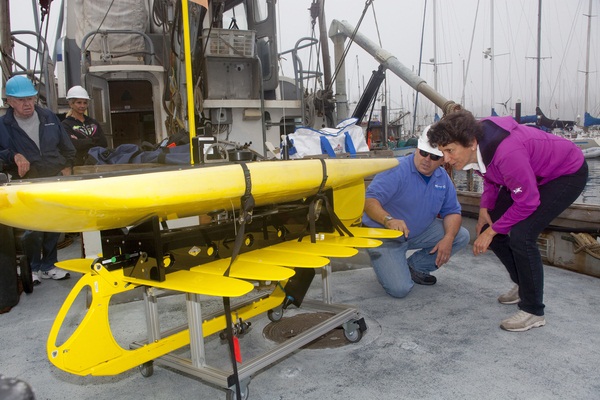The Wave Glider, a remarkable little renewably powered seagoing robot, is apparently also fearless. It’s now a shark tracker.
Powered by the waves and with a solar panel that provides electricity for sensory payloads, the Wave Glider has been recruited by Stanford University marine sciences Professor Barbara Block to work the waters off the California coast between Monterey Bay and Tomales Point.

According to Block’s lab [PDF], the 7-foot-long Wave Glider, along with moored buoys, will pick up signals from acoustic tags on white sharks that pass within 1,000 feet, then relay the data to Block’s team back on shore.
“Our goal is to use revolutionary technology that increases our capacity to observe our oceans and census populations, improve fisheries management models, and monitor animal responses to climate chage,” Block said in a statement.

Whether the Wave Glider qualifies as revolutionary, who knows? Seems like it. Anyway, it’s definitely way cool.
From above, only the sleek Float is apparent, rolling along the surface of the water, its topside covered by solar cells. But down below, tethered to the Float, is the Sub.
“A rising wave lifts the Float, causing the tethered Sub to rise,” developer Liquid Robotics explains. “The articulated wings on the Sub are pressed down and the upward motion of the Sub becomes an up-and-forward motion, in turn pulling the Float forward and off the wave. This causes the Sub to drop, the wings pivot up, and the Sub moves down-and-forward. This process is repeated again and again as long as there is wave motion on the surface, even the smallest amount.”
By using the sea’s never-ending motion for power, the Wave Glider can go out on virtually unlimited missions. It comes equipped with GPS and a navigation system that allows it to be guided on its journey. And because it is always on the surface – unlike submergible research vessels – it’s always available to deliver and receive data via satellite.
Earlier this year, a caravan of Wave Gliders traveled from the mainland to Hawaii.
The Wave Glider’s new mission with Stanford’s Block was featured on the Discovery Channel Thursday in the broadcast,“Great White Highway.” The Wi-Fi network that Block is developing also comes with a free Apple app, called SharkNet, that allows the public to follow the tracking of animals in realtime.

According to the Stanford release, the app will notify users when a white shark passes within around 1,000 feet of one of the sensors out in what the researchers call “the Blue Serengeti.”
“People realize this is important, but it’s hard for them to connect on a a visceral, personal level to the incredible biodiversity in their own backyard,” Stanford’s Randall Kochevar, who developed the app, said in a statement. “Through this app, we’re able to put the Blue Serengiti right in their hands. They can follow individual sharks and learn about their lives and feeding habits.”